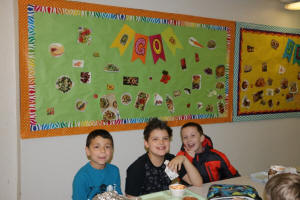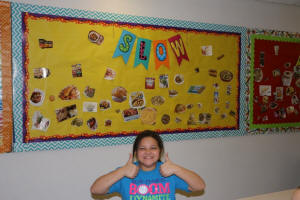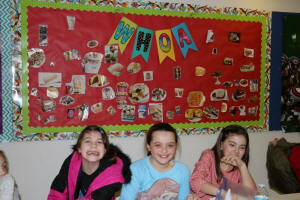|
 At Mount Pulaski Grade School the teachers and staff have a plan
that seems to be working in favor of the students and it benefits
everyone involved. That plan features the latest in tablet computer
technology designed by Apple, Inc and called the iPad, and a program
designed to encourage eating healthy and staying physically active
called CATCH. Combine the two and you have a win-win situation for
the approximately 350 students of Mount Pulaski Grade School. At Mount Pulaski Grade School the teachers and staff have a plan
that seems to be working in favor of the students and it benefits
everyone involved. That plan features the latest in tablet computer
technology designed by Apple, Inc and called the iPad, and a program
designed to encourage eating healthy and staying physically active
called CATCH. Combine the two and you have a win-win situation for
the approximately 350 students of Mount Pulaski Grade School.
Mount Pulaski Grade School Principal Gene Newton is pleased with the
early success of the program called the Personalized Learning
Initiative or PLI that utilizes the iPad. Newton explained, “This is
the second year in the initiative and we’ve got iPads for every
student in the district, K-12. Basically, the instruction is going
away from teacher-led to student-involved and the teacher is more of
a facilitator than to stand over as being a leader. We are getting
there. It’s a big adjustment to get to right away,” he added.
Teachers can also facilitate a more engaging learning experience at
an individualized pace with the use of technology, according the
information on the Mount Pulaski Grade School website. In addition,
with students using iPads and teachers using the MacBook Air, “this
incorporation of technology will work in tandem more efficiently to
align transformed teaching styles and methods to the diverse ways in
which students learn.”

Newton continued to rave about the iPads and their many features,
“We have a lot of things going on right now where kids are making
their own videos and making their own movie presentations with the
iPads. They use keynote, pages, all these apps from Apple. We work
with Apple and the teachers all have a math book that works with the
iPads. In Science classes, all the textbooks are on the iPad.”
Indeed the world is at the fingertips of these students.
Newton emphasized the importance the iPad plays at Mount Pulaski
Grade School. “The big thing is the kids have more access to
information. They always have information. Before they would have to
go to the computer lab and they would all get their half hour in the
lab. Now, they all have it at all times. So if they are doing a
research project, every class can be doing something at the same
time. The information that they all have in their hands now is
unbelievable. They all have the internet right there in their hands.
They can look up anything.”
However, Technology Coordinator Heather Fricke does monitor what the
kids can look up, says Newton.
“In education, YouTube is where you can look up anything on there
and somebody is teaching it somewhere. If you didn’t understand it
here, you can go home, you can download it and watch somebody else
teach it; some [that are] experts in the field who might give you a
different viewpoint on it. Some kids are taking advantage of that,”
Newton said. He also looks for that to evolve even more as kids grow
and adapt to the new technology.
Apps
Students also use the many apps readily available to their
advantage. Newton explained, “All the kids have apps on the iPads
and the teachers let the kids download educational apps.”
The kids can also download three apps for their own entertainment,
to have fun, says Newton. “One added bonus of the iPad for me is
during down time, like when the kids come in early in the morning
and sit in the bleachers, well those little kids have all got them
out doing racing games and even math games. They do math games on
them and they do not even know they are doing math games. There is
not near as much disruption in the morning. Also when there is
indoor recess some kids will play on their iPads.” Again, everybody
wins.

Electronic homework
According to Newton, there is also an app called eBackpack where
teachers can give assignments, the students do the assignment and
send it back to the teachers for grading. This limits the use of
paper and has been very positive as well.
Summing up the success of the PLI, Newton proclaimed, “Information
is just so readily available that it made sense to get it to the
kids. I really think that the Mount Pulaski District was one of the
first to go all the way, K thru 12. Every student has an iPad.” In
addition to having the iPads at school, students can take the iPad
home as long as the insurance fee has been paid. If they do not want
to pay the fee, then the iPad stays at school and is charged
overnight at school, says Newton.
Staying active and healthy in the computer age
Moving on to CATCH, Fricke explained what the program that
emphasizes a healthy and active lifestyle stands for: Coordinated
Approach to Childhood Health - CATCH. “We are partnered with Logan
County Healthy Communities Partnership and Abraham Lincoln Memorial
Hospital. They provide support and bring in people that teach the
students about eating right and being active.” Fricke was pleased to
announce, “They have given us about $7,000 worth of PE equipment and
the students are learning all kinds of new games and activities that
they do in PE from basketball to hula hooping.”

Students at MPGS run
during PE class.
The students are active constantly
during their PE class as part
of the CATCH program. CATCH is also about
educating the students on healthy eating. Fricke shared the
importance of learning good eating habits at a young age and also
emphasized other key factors. “We also give out information to
parents on eating right at home, getting enough sleep and being
active instead of being on the video games."
Fricke continued, "We are also giving out little cards to the kids
when we see them being active. When they have a choice to sit and do
nothing as opposed to being active, they get a little card for being
active. We also do that for lunch. So if we see them eating all the
healthy parts of their lunch or if we see that they are bringing in
apples now instead of a Snickers bar, we give them a little card.
Fricke said, "Then we are doing drawings and they get to put all
their cards in a bucket.” The prizes that are awarded will keep the
students active, like baseball bats and frisbees, said Fricke. She
added, “We are just trying to encourage them to get off the couch
and be healthy.”
[to top of second column] |
 This goes for the teachers, too. Every teacher has also set a goal
for themselves, in addition to group projects in their classroom to
benefit the entire class. Mrs. Fricke mentioned her goal is to go to
spin class three days a week and drink six glasses of water a day.
A billboard in the cafeteria also features posters identifying
different foods that the students can see and learn from daily.
According to Fricke, there are three types of foods listed on the
posters: Go Foods, Slow Foods and Whoa Foods.
Go Foods, “You can always go to these if you’re hungry.”



The GO, SLOW, and
WHOA food posters
that the students see everyday
in the school's cafeteria Slow Foods, “These can put on
extra calories, but are not necessarily bad for you.”
Whoa foods, “Everything is fine in moderation but I should really
think about if I’ve already had this, this week maybe I better not
have another candy bar, whoa, lay off.”
Finally, Fricke offered the philosophy behind the program, “The
encouragement is to eat more Go Foods than Slow Foods and more Slow
Foods than Whoa Foods.” Makes perfect healthy sense.
Lastly, the active lifestyle for the students kicks into high gear
during their daily Physical Education classes.
 Brent Grisham, the PE teacher at MPGS, explained the new method in
this fashion, “Basically it’s kind of a shift in the PE philosophy
from old, where kids would come in and be sitting on their spots and
waiting to do stretches and stuff of that nature. To now, when they
get dressed for PE they immediately come into the gym and start
walking. Instead of the downtime of maybe 5-10 minutes of waiting
until everybody was situated, they are already moving. The idea
behind that is not have any time at the beginning of class where
they are not physically active. Then we go right into our regular
running or whatever we do after that.”
Grisham added that there are three CATCH programs geared towards the
different age groups: Kindergarten, first and second grades; third,
fourth and fifth grades; sixth, seventh and eighth grades. “There
are all kinds of games and activities within each CATCH program that
are age specific with the games based on movement.”
The old elimination games are really being 'eliminated' this day in
age, as Grisham explained, and the kids seem to be having more fun
than ever. “Instead of sitting out when you get out, you do
exercises like jumping jacks on the side and then go back into the
game. They are fun games with unique names so the kids, especially
the younger kids, really latch onto the names. The good part about
it is, they kind of forget how active they really are.
Traditionally when you tell kids to take off and run, that’s boring.
But when you get a game where they are active constantly they forget
how much they are actually doing. By the time class is over they’re
hot and sweaty and they’ve spent a good 20-25 minutes of being
physically active and enjoying it at the same time.”
Now after all the physical activity and healthy eating, it’s time to
hit the iPads again for more learning at Mount Pulaski Grade School.


|